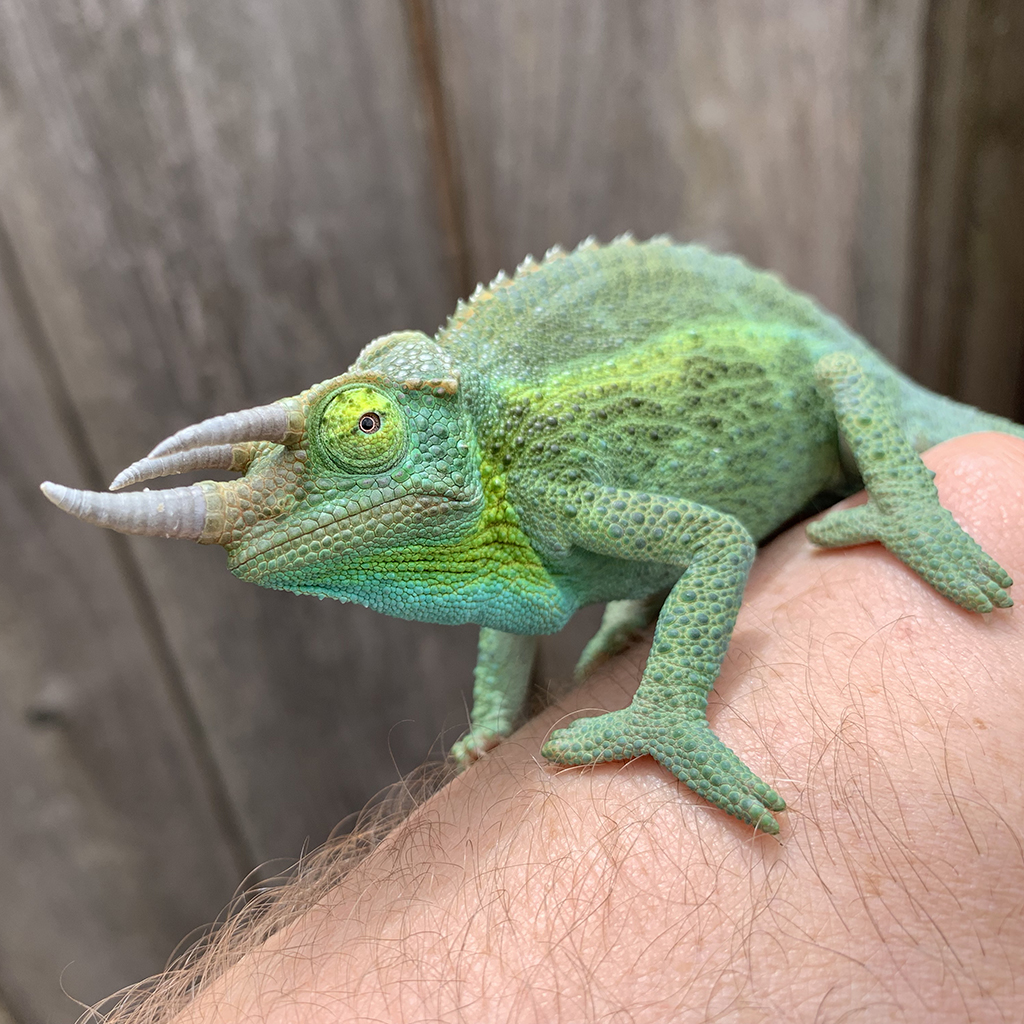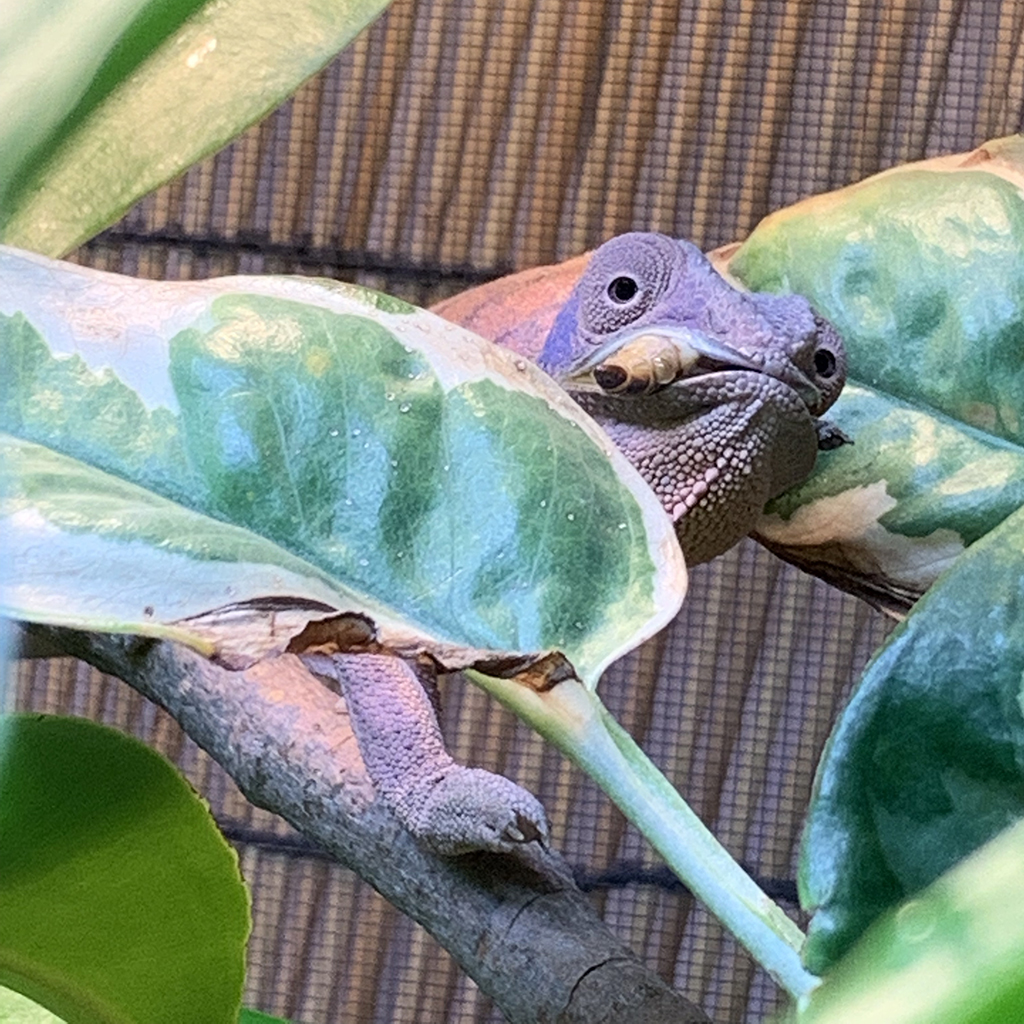Summary: Chameleons & Plants
- Plants create a living environment for your chameleon to live in
- Plants provide drinking surfaces, hiding spots, and humidity
- A fully planted cage is a beautiful piece of natural art
Introduction to Plants

In the design phase we used green clouds to plan where we wanted our plants to go. Now it is time to replace those green clouds with actual plants! If you are an enthusiastic plant person you may have already decided which variation of Pothos you want and have that Manjula on special order. Others are still figuring out the difference between pothos and ficus and why in the world do we call it pothos when that isn’t its real name anymore?!?!? Well, we won’t be uncovering the secrets of the universe in this module, but you will have a working knowledge of plants.
We’ll start by acknowledging an obvious truth. Plants are living things and need food and water like every living creature. And like every living creature, they have their own way of getting what they need. We need to provide that to them so they can thrive. There are many varieties of plants that will live in our chameleon cage light and humidity conditions so keeping a vibrant living environment is not that hard with a basic understanding.
Live vs. Plastic Plants
In our cage build project here we will work only with live plants. Philosophically, plastic plants take us in the opposite direction from being naturalistic. Our goal of matching our chameleon’s home environment requires live plants. So we will not be using them here. That said, plastic plants have been used for decades. They are cleaned easily and have a valuable spot in breeding projects that require frequent and/or thorough cage cleaning (such as in a quarantine situation). There are cautions though. If you are using fake plants, use only ones designed for the reptile industry. Fake plants produced for the art industry or interior decorating are not designed to be non-toxic or even stay intact when sprayed with water and it will be difficult for you to check how safe they are. I would especially caution the use of plastic plants with veiled chameleons who are known to take bites out of leaves. Swallowing plastic introduces a host of complications that we can only speculate at here. I advocate live plants and will guide you step by step into how to make them work. Follow the guidelines in this course and fake vs. plastic is not even a consideration you need to have on your plate.
Basic Plant Care
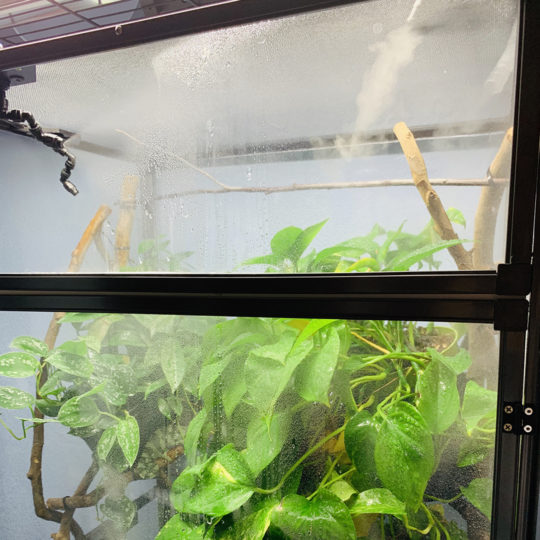
A common complaint amongst chameleon keepers is that they cannot keep a plant alive. We definitely need to change this! Not only are plants a beautiful part of the chameleon environment, but if the environment is suitable for a chameleon, plants should thrive with almost no additional effort from you. Plants really need just light and water from you and the right temperature range. The most common houseplants are well suited for the cage conditions of the most common chameleons. The biggest problems with keeping plants alive are lack of light and lack of water. Although there are a number of other reasons why a plant could die, a good indication that your cage is a healthy environment for your chameleon is a lush, thriving community of plant life.
Dangerous Plants
We are rightfully concerned about the plants we put in our cage and we should be careful in our choices. Dangers from plants come in three main sections: thorny plants, poisonous plants, and pesticides. Some may say that there is a fourth danger, and that is of the plants eating your chameleons, so we will just have to call out carnivorous plants specifically!
Thorns and Rough Edges
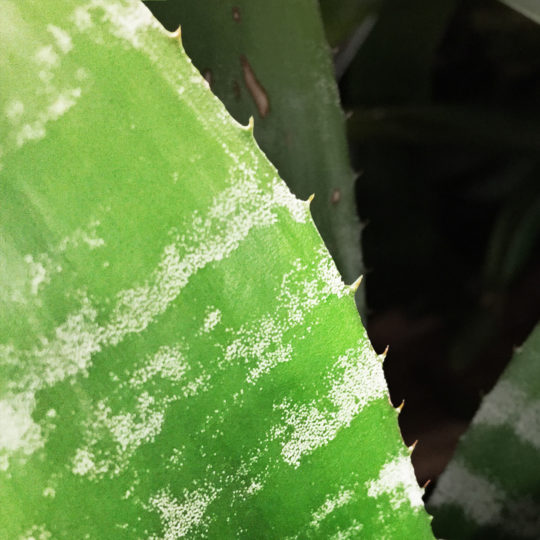
It is obvious to most that we do not want to put plants with thorns or any other cutting surface in our chameleon cage. Roses, Stinging Nettle, select bromeliads, and bougainvillea are examples of plants that are not on the top of our use list. It is true that that we want to make our chameleon’s environment match their wild environment as closely as possible and that chameleons negotiate thorns just fine in the wild. Some chameleons live in bushes with some very nasty thorns and enjoy the protection they offer. In reality, including a thorny vine in the cage is more of a danger to you trying to maintain the space! Regardless of their ability to negotiate the thorns, thorns and sharp edges do take space which your chameleon can not use. So including them is restricting our chameleon’s perching choices in an already relatively small space.
Beyond this, just be observant. Sometimes plants that look fine are actually hiding thorns. Some bromeliads have saw-tooth leaf edges. And some plants that are advertised as “thornless” such as Lady Banks roses or thornless blackberry will end up with thorns despite the grower’s best intentions.
Poisonous Plants
We in the chameleon community are handicapped when it comes to determining what plants are poisonous to chameleons. Most poison charts available are for humans, dogs, cats, birds, and horses. The closest charts we can get are for tortoises, but those do not usually include ornamentals. The problem with charts that are put together for other animals is that chameleons are different. Even on the charts we have there are difference in what is okay for humans, but will kill birds or be poisonous to dogs. The fact is that we do not know what is poisonous to chameleons and these charts are not much help. The only thing they truly do is give us a false sense of security if we decide to use them to guide our plant selection. Something that may be fine for dogs could kill a chameleon and we already know that Pothos, one of the most widely used plants in chameleon cages, has oxalates which land them on the poisonous list for dogs. Decades of use and direct observations of veiled chameleons eating Pothos leaves with no reported issues has us concluding that Pothos are not poisonous to veiled chameleons in the amount that they eat.
The reason this is so tricky is that even if a plant would be dangerous to ingest, it would poison the chameleon only if the chameleon ate enough to be an effective dose. Almost all chameleons, the Veiled Chameleon being the most notable exception, have little interest in chewing up a leaf. Thus a plant which is known to have cyanide in its leaves has, anecdotally, shown itself to be okay to use with chameleons over decades of my personal use in my cages. This does not mean that there will never be an issue with a poisonous plant in a chameleon cage, but it does mean that we should keep perspective. I would consider the modern chameleon keeping era to have started in the early 1980s. Since that time people have been grabbing any plant they could find and using them in chameleon cages. There is no shortage of plants poisonous to humans being used in cages for long periods of time. We have enough time under our collective belts to draw conclusions from the fact that there is no rash of plant poisoning incidences in the beginner community from putting the wrong plants in their cages. Chameleons tend to reward wrong decisions by dying. There is still much to learn about chameleons and plants so I would never say that we know the absolute answer. But I can say that not seeing an obvious trend with the number of people who have used Pothos, Ficus, and Schefflera, which are supposedly poisonous, is a data point in itself. Whether they are poisonous to chameleons or not, we currently have no evidence of danger and decades of evidence of safety. That said, we should always use common sense. For example, when a Ficus bejamina tree breaks a branch or leaf a milky white substance is leaked out. Wipe it up quickly if that happens. Poison or not, there is no need to allow that to accidentally get in your chameleon’s eye or on its skin. It is always worth determining what is poisonous about the plant in question. For example, pothos and schefflera are on poison lists because they have oxalates in their leaves which causes mechanical damage as they are chewed and go down the throat. For a chameleon that only licks water off the surface the poison nature of this plant will not be an issue.
Regardless of what we know or don’t know, the community just wants a safe plant list. I will provide on this website recommended plants, but since there is little in the literature to point to any poisoning and there is no community tribal evidence of any poisoning, there is no relevant list. This does not mean there aren’t people taking the dog/cat lists and rebranding them chameleon safe plant lists. And there is no shortage of social media “experts” that embrace these lists as a guide for how they can police and “correct” new keepers. But when you dig back through all their references you will find their confidence is vastly out of balance with their evidence.
That said, there also is also no evidence that following a dog/cat list is dangerous either. So it is okay to decide to play it safe even if it is a false sense of security.
The plants on the Chameleon Academy Chameleon Plant list is not exhaustive, but have been tested.
Pesticides
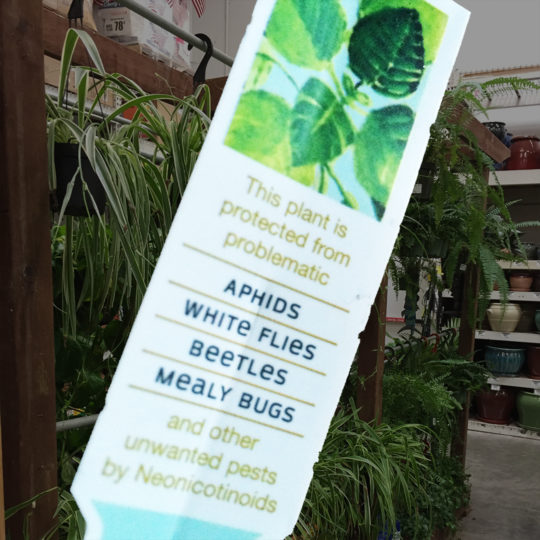
There are two types of pesticides: Contact and systemic. A contact insecticide would be sprayed on the surface of the plants to be protected and the systemic would be one that is internal to the plant. In our ornamental plants, the insecticide of choice is systemic. These will affect only the plant eating bugs and not the predatory bugs .
It is a good idea to gently wash the leaves of the plant you bring in to your chameleon cage to wash off whatever may be sitting on there. And the community has long recommended that the leaves be washed with mildly soapy water to remove the insecticides. Unfortunately, since the most common pesticide in use is the systemic type, washing does not remove the poison.
The most common systemic insecticide in house plants up until 2017 has been neonicotinoides. “Neonics” are said to not pass through the blood/brain barrier in vertebrates. I have been unable to find any report of reptiles being poisoned in relation to neonics. The fact that we have had veiled chameleons chewing on houseplants that almost certainly have contained neonics and have shown no signs of poisoning suggests that it could be true that it will not affect chameleons. Of course, this is speculative, but the fact that we do not experience mysterious deaths or sicknesses commensurate with the number of home improvement store plants used in veiled chameleon cages tells us something.
There is good and bad news on the horizon. Due to US consumers connecting neonics to bee deaths, the major home improvement chains are working on phasing out neonics from their plant offering. The good news of one less pesticide for us to worry about is tempered by the bad news that whatever systemic pesticide is used to replace neonics, it may or may not be toxic to chameleons. We have lived with neonics, whether we knew it or not, for two decades and we have a fairly good idea that they are, at least, some what safe to be used with chameleons. Any new systemic will start us having to test all over again. While I am sure the new systemic will have all the assurances of safety that neoics did, nothing beats having two decades of field testing to back up assurances from companies wanting to protect their interests.
The bottom line is that it doesn’t hurt to be careful and cautious, but, also, there is no record of poisoning from insecticides on/in plants.
Uses For Plants
As chameleons live in and around plants and leaves all their life they have developed a strong relationship with them and depend on them for their environment. We can break the use and benefit of plants into four main functions.
Drinking Surface
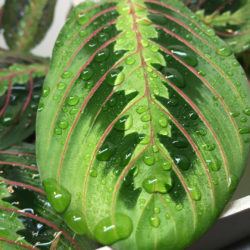
As arboreal creatures, chameleons have had to learn to get water up in the trees. Although a chameleon will drink from any surface and even let water flow down their face into their mouth, leaves are the primary drinking surface. Thus we will want to provide plants that have wide leaf surface either with large leaves or else a tight enough density of leaves that water collects.
Exposure Gradient
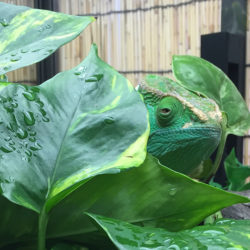
Plants are our main tool in providing an exposure gradient. The exposure gradient allows the chameleon to choose how visible to the outside world he or she is. Simply put, your chameleon needs at least one chameleon appropriate hiding place. Ideally, they have variety to choose from that have varying levels of exposure. Plants are ideal to create this effect due to their natural appearance and the fact that plants are what (most) chameleons are used to when it comes to environment.
Humidity Pockets
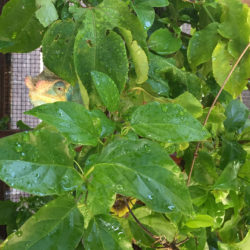
One of the gradients we strive to create in our chameleon cage is a humidity gradient. Creating a humidity gradient is tricky as you tend to have a level of relative humidity and the changes in humidity tend to be over time and not over space. That just means that humidity fluctuates over the course of the day and is not a linear progression from one point in space to another like distance from a spot light can provide for heat. But there are microclimates in nature where humidity spikes. And it is in our best interests to create areas in our cage where our chameleon may find increased humidity if they need it. Live plants provide humidity by transpiration, which is the release of water into the air by leaves, and by the wet soil.
Aesthetics
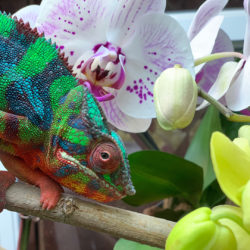
And finally, please don’t forget the importance of the chameleon environment being beautiful to the human eye or even just fun. Create an environment that is pleasing to you and the people visiting your home whether physically or digitally. A beautifully planted cage will be a source of peace and wonder to you and will be a great introduction to anyone stumbling across your hobby. If you have family members who are skeptical of your new hobby, a lushly planted environment that you maintain to a beautiful standard can go a long ways to their acceptance or even interest. Once you lay the foundation of functional plants you can include plants that add color, are of interesting shape, or even need to be fed with insects themselves!
Soil controversy
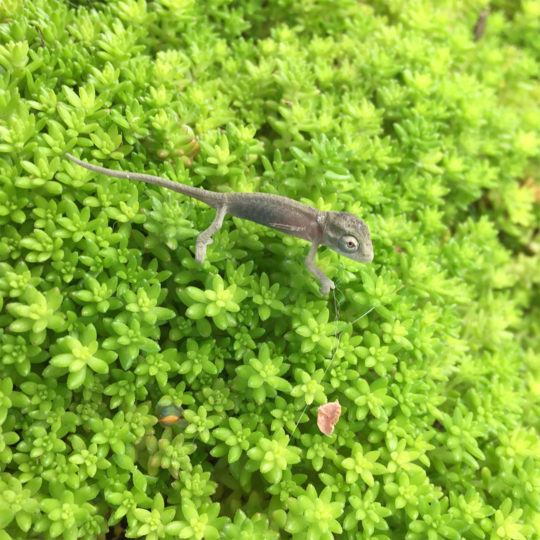
Having open soil in a cage with a chameleon tends to be controversial. Some people are hyper vigilant that there is no exposed soil surface. They cover any potted plant soil with large rocks or marbles so a chameleon has no opportunity to bring back dirt or anything else that may be harmful when they hunt for insects. Then there are the breeders that keep their chameleons in soil floor cages and can’t understand what the fuss is about.
The concern with soil is that there could be components to the soil that could be harmful to your chameleon if accidently ingested. Small rocks, wood chips, and fertilizer balls top the list of concerns. Then there is the situation where the chameleon will go down and literally eat the soil. Geophagia, or the ingestion of soil, is done to supplement a diet that is lacking in some mineral. Although an appropriate response would be to cover the bare soil, the real solution is to fix the diet and supplementation so that the chameleon is not driven to eat soil.
There is no harm in covering the soil top with rocks. But, also, with the proper husbandry, there is really no need.
Fertilizer balls are a real concern, though. These are the small BB sized capsules that are put into soil as a slow release fertilizer. This would not be a good thing to be ingested. If your plant has these readily available a repotting to a completely organic soil would be appropriate.
Further Research
One of the joys of chameleon keeping is creating a beautiful environment for them to live in. Chameleon keepers often become plant collectors and even people who couldn’t keep plants alive before become skilled plant parents! This module is just a basic introduction to chameleons and plants. For a much deeper exploration check out the dedicated plants for chameleons page
Conclusion
Chameleon keeping is more than just keeping an animal breathing. It is creating the environment where that animal can thrive and feel at home. A strategically and densely planted cage provides that natural living space. We can take this further and further. We can add a bio-active substrate and then we can research plants that may come from the chameleon’s natural environment. But, for now, a well planted cage using our commonly available house plants will provide an excellent living space for our chameleon.
Navigation
This seminar is part of the introductory course Chameleon Basics which, in turn, is a module within the even larger Term 1: Getting Started With Chameleons.
In our next module we take a look at the basics of feeding chameleons. What does it take to keep these guys fueled?


